96 out of 100 households in Central Visayas use improved source of drinking water
Improved sources of water protect against contamination so that the water is safer to drink; these include piped into dwelling/yard/plot, piped to neighbor, public tap/standpipe, tube well/borehole, protected dug well, protected spring, rainwater, and bottled water/refilling station.
Based on the results of the 2017 National Demographic and Health Survey (NDHS 2017), 95 percent of households in the Philippines use an improved source of drinking water. Among 17 regions, Central Visayas ranked 6th in proportion at 96.2 percent or 96 out of 100 households (see Figure 1).
Figure 1. Proportion of households in Central Visayas by source of drinking water, 2017
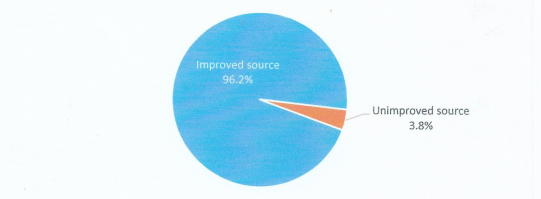
71 out of 100 households use improved sanitation facilities in Central Visayas
In 2017, 76 percent of Filipino households use improved sanitation facilities, which are defined as non-shared facilities that prevent people from coming into contact with human waste and thus reduce the transmission of cholera, typhoid, and other diseases. In Central Visayas, 70.8 percent of the household population uses improved sanitation. Central Visayas recorded a relatively low of household using unimproved sanitation at 29.2 percent; this includes 14.5 percent of households with a shared toilet facility of an otherwise acceptable type, 2.0 percent with an unimproved facility, with 12.6 percent having no facilities at all.
Figure 2. Figure 2. Proportion of households in Central Visayas with access to improved sanitation, 2017
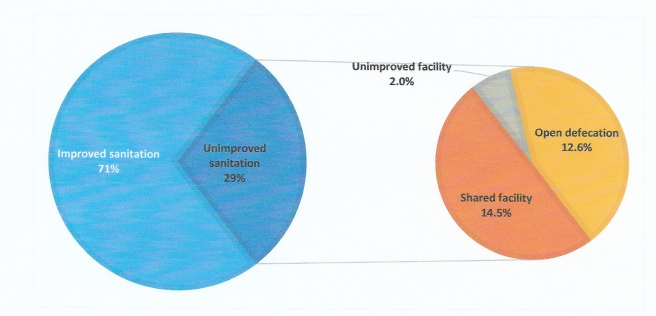
59 out of 100 persons have any PhilHealth Insurance in Central Visayas; majority are members through the formal economy
Fifty-nine percent of the household population in Central Visayas has any form of PhilHealth insurance: 28 percent are members through the formal economy, 3 percent through the informal economy, and 18 percent are indigent members. Another 7 percent are senior citizen members, 2 percent are sponsored members, 1 percent are lifetime members, and 1 percent are overseas Filipino members. Twenty-seven percent of the population has other forms of health insurance such as the Government Service Insurance System (GSIS), the Social Security System (SSS), or private insurance.
7 percent of women age 15-19 have begun childbearing
The issue of adolescent fertility is important for both health and social reasons. Children born to very young mothers are at increasing risks of sickness and death. Teenage mothers are more likely to experience adverse pregnancy outcomes and to be constrained in their ability to pursue educational opportunities than young women who delay childbearing. In Central Visayas, 7.4 percent of women age 15-19 have begun childbearing, which is lower than the national estimate at 9 percent. Out of 7.4 percent, 6.3 percent have had a live birth and 1.1 percent were pregnant at the time of the interview.
52 out of 100 women in Central Visayas age 15-19 use contraceptive methods for family planning
Family planning refers to a conscious effort by a couple to limit or space the number of children they have through the use of contraceptive methods. Contraceptive methods are classified as modern or traditional. Modern methods include female sterilization, male sterilization, intrauterine contraceptive device (IUD), injectables, implants, pills, condoms, standard days method (SDM), and lactational amenorrhea method (LAM). Methods such as rhythm, withdrawal, and folk methods are grouped as traditional.
Table 1 shows percent distribution of currently married women by the contraceptive method they currently use. In Central Visayas, 52.1 percent of currently married women use a method of family planning. Approximately thirty-seven percent (36.7%) are using modern methods while fifteen percent (15.4%) are using traditional methods. Among currently married women, the most popular methods are the pills (used by 18 percent), rhythm (used by 7.6 percent) and withdrawal (used by 7.5 percent).
Table 1. Percent distribution of currently married women age 15-49 by contraceptive methods currently used in Central Visayas, 2017
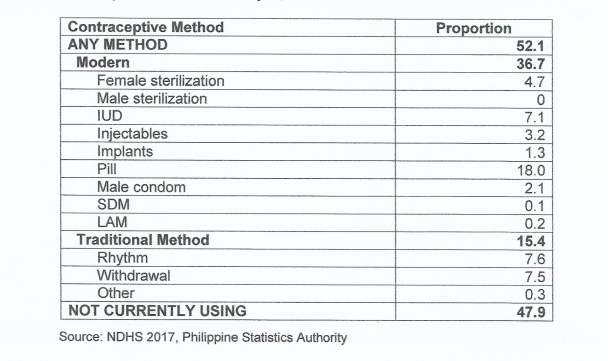
About 1 out of 5 currently married women in Central Visayas have unmet needs
The proportion of women who want to stop childbearing or who want to space their next birth is a crude measure of the extent of the need for family planning, given that not all of these women are exposed to the risk of pregnancy, and some may already be using contraception. Women who want to postpone their next birth for 2 or more years, or who want to stop childbearing altogether but are not using a contraceptive method, are said to have an unmet need for family planning. Pregnant women are considered to have an unmet need for spacing or limiting if their pregnancy was mistimed or unwanted, respectively. Similarly, amenorrheic women are categorized as having an unmet need if their last birth was mistimed or unwanted. Women who are currently using a family planning method are said to have a met need for family planning. Total demand for family planning services comprises those who fall in the met need and unmet need categories.
Based on the 2017 NDHS results, fifty-two percent (52.1%) of currently married women in Central Visayas are currently using contraceptive methods, as presented in Table 1. Table 2 below shows that about twenty percent (19.6%) of currently married women have an unmet need for family planning services, which implies that, seventy-two percent (71.8%) have a demand for family planning. At present, about seventy-three percent (72.7%) of the potential demand for family planning is being met, with fifty-one percent (51.2%) is met by modern methods.
Table 2. Need and demand for family planning among currently married women in Central Visayas, 2017
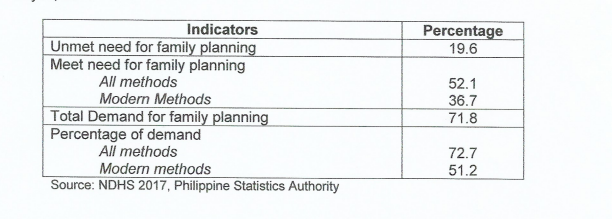
In Central Visayas, 90 percent of women who have given births were delivered by a health provider, higher than the national estimate
Proper care during pregnancy and delivery is important for the health of both the mother and the baby. In the NDHS 2017, women who have given birth in the 5 years preceding the survey were asked a number of questions about maternal care. Mothers were asked whether they had obtained antenatal care during the pregnancy for their most recent live birth in the 5 years preceding the survey and whether they had received tetanus toxoid injections while pregnant. For each live birth over the same period, mothers were also asked what type of assistance they received at the time of delivery and whether the birth was delivered by cesarean section. Finally, women who had a live birth in the 2 years before the survey were asked if they received a postnatal check during the first 2 days after birth. Table 3 below summarizes information on the coverage of these maternal health services.
Table 3. Maternal care indicators among women age 15-49 in Central Visayas, 2017
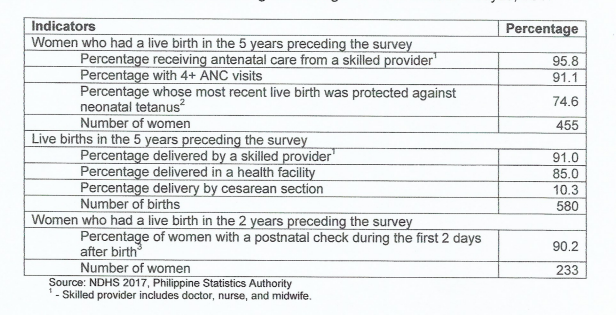
Antenatal care (ANC) from a skilled provider is important to monitor pregnancy and reduce morbidity and mortality risks for the mother and child during pregnancy, at delivery, and during the postnatal period (42 days after delivery). Table 3 shows that almost ninety-six (95.8) percent of women who gave birth in the 5 years preceding the survey in Central Visayas received antenatal care from a skilled provider at least once for their last birth. Ninety-one percent (91.1%) of women had four or more ANC visits.
Tetanus toxoid injections are given during pregnancy to prevent neonatal tetanus, a major cause of early infant death in many developing countries, often due to failure to observe hygienic procedures during delivery. Result shows that three out of four women in Central Visayas with a birth in the 5 years before the survey received sufficient doses of tetanus toxoid to protect their last birth against neonatal tetanus.
Furthermore, survey data show that in the Central Visayas, ninety-one percent of the births in the 5 years preceding the survey were delivered by a skilled provide, higher than the national estimate. Eighty-five percent were delivered in a health facility and ten percent were delivered by cesarean section.
A large proportion of maternal and neonatal deaths occur during the first 48 hours after delivery. Thus, prompt postnatal care (PNC) for both the mother and the child is important to treat any complications arising from the delivery, as well as to provide the mother with important information on how to care for herself and her child. Safe motherhood programs recommend that all women receive a check of their health during the first 2 days after birth. In Central Visayas, the percentage of women with a postnatal check during the first 2 days after birth was recorded at 90.2 percent.
72 out of 100 children in Central Visayas have received all basic vaccinations
Universal immunization of children against common vaccine-preventable diseases is crucial to reducing infant and child mortality. The NDHS 2017 collected information on the coverage of all of these vaccines among children born in the 3 years preceding the survey. The information obtained in the survey on differences in vaccination coverage among subgroups of children is useful for program planning and targeting resources towards areas most in need. Table 4 shows that 72.2 percent of children in Central Visayas age 12-23 months received all basic vaccinations and 60.8 percent received all age-appropriate vaccinations. Eighty-three percent (82.6%) of children received the BGC vaccination, 72 percent the birth dose of HepB, 82.6 percent the first dose of polio, and 82.4 percent the first dose of DPT, HepB and Hib. Approximately seventeen percent (16.6%) of children age 12-23 months have not received any vaccinations at all.
Among children age 24-35 months, 62 percent received the second dose of measles or MMR vaccine. Overall, only 47 percent in this age group have received all age-appropriate vaccinations.
Table 4. Percentage of children in Central Visayas age 12-23 and 24-35 months who received specific vaccines
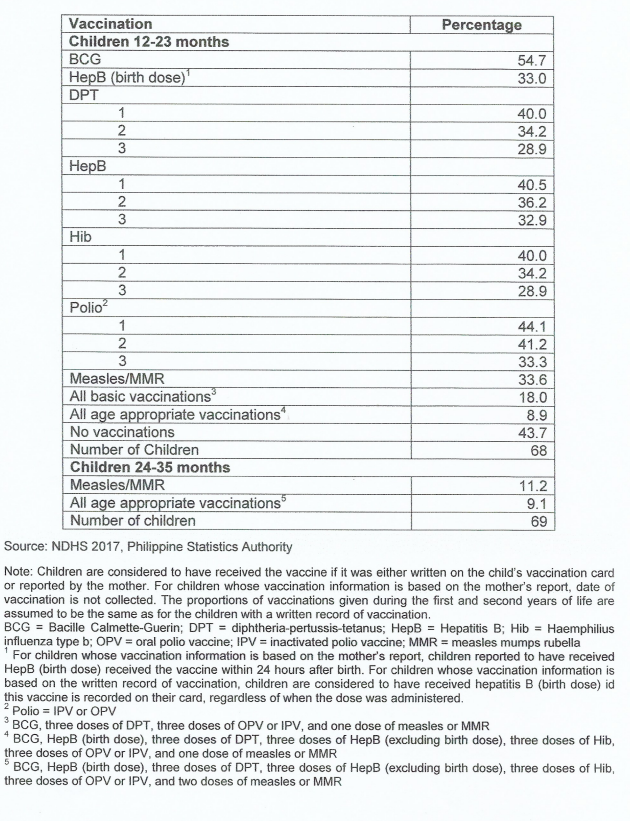
Only 16 percent of women in Central Visayas have comprehensive knowledge of HIV prevention
Sixty-five percent (64.7%) of women age 15-49 in the region know that consistent use of condoms is a means of preventing the spread of Human Immunodeficiency Virus (HIV). This awareness is very close to the national estimate of 66.2 percent. Eighty-two percent of women believe that limiting sexual intercourse to one faithful, uninfected partner can reduce the chance of contracting HIV. Six in ten women (60.4%) know that both using condoms and limiting sexual intercourse to one uninfected partner are means of preventing HIV.
Only 16 percent of young women (age 15-24) in the region have comprehensive knowledge of HIV prevention. This is lower than the national estimate of 20 percent.
Almost 1 percent of women age 15-49 reported having had two or more sexual partners during the 12 months prior to the survey. Among women who ever had sexual intercourse, the mean number of lifetime sexual partners is 1.7.
Only 5 percent of women in Central Visayas have ever been tested for HIV; 3 percent have been tested for the past 12 months of the last test
Knowledge of HIV status helps HIV-negative individuals make specific decisions to reduce risk and increase safer sex practices so that they can remain disease-free. Among those who are HIV-positive, knowledge of their status allows them to take action to protect their sexual partners, to access treatment, and to plan for the future. To assess awareness and coverage of HIV testing services, 2017 NDHS respondents were asked whether they had ever been tested for HIV. If they said that they had been tested, they were asked whether they had received the results of their last test and where they had been tested. If they had never been tested, they were asked whether they knew a place where they could go to be tested.
In the region, 33.6 percent of the women age 15-49 years old know of a place where they can get an HIV test. Only 5.1percent of women have ever been tested for HIV and received the results of their last test, and 3.4 percent were tested in the past 12 months and received the results of their last test.
Central Visayas ranked fifth among the 17 regions with high proportion of ever-married women age 15-49 years old who have ever experienced either emotional, physical or sexual violence
Violence against women is a pervasive and worldwide problem in almost all societies. It permeates all social, cultural, economic, race and religious sectors. Violence can take many forms, including physical, sexual, emotional, economic, and psychological abuse. It can have devastating consequences on the short- and long-term health and well-being of the women affected as well as their over-all quality of life (Hutchins and Sinha, 2013).
The Republic Act No. 9262 or the “Anti-Violence Against Women and Their Children Act of 2004” is one of the Philippine government’s initiatives in addressing the issue on violence against women. Under this Act, violence against women and children is classified as a public crime and penalizes all forms of abuse violence within the family and intimate relationships (Philippine Commission on Women).
As was the case in the 2008 and 2013 NDHS surveys, the 2017 NDHS included a Women’s Safety Module to collect information on the extent of violence against women in the country. The questionnaire comprises questions on the women’s experience of physical, sexual and emotional violence from their husbands or partners as well as by other family members or unrelated individuals.
In the region, 33.7 percent of the ever-married women age 15-49 years old have ever experienced emotional violence, 14.5 percent have ever experienced physical violence, and 6 percent ever experienced sexual violence by their current or most recent husband or partner. Central Visayas ranked fifth among the regions with high proportion of ever-married women age 15-49 years old who have ever experienced either emotional, physical or sexual violence at 43.2 percent.
Table 5. Percentage of ever-married women age 15-49 who have ever experienced emotional, physical or sexual violence committed by their husband/partner, 2017

Technical Notes
The 2017 Philippines National Demographic and Health Survey (NDHS) is the sixth Demographic and Health Survey (DHS) conducted in the Philippines as part of The DHS Program and the 11th national demographic survey conducted since 1968. It was implemented by the Philippine Statistics Authority. Data collection took place from 14 August to 27 October 2017. Funding for the NDHS 2017 was provided by the Government of the Philippines. The United States Agency for International Development (USAID) provided technical assistance and equipment through ICF under The Demographic and Health Surveys (DHS) program, which assists countries in the collection of data to monitor and evaluate population, health, and nutrition programs.
The sampling scheme implemented provides data representative of the country as a whole, for urban and rural areas separately, and for each of its administrative regions. The sample selection methodology for the NDHS 2017 is based on a two-stage stratified sample design using the Master Sample Frame (MSF), designed and compiled by PSA. The MSF is constructed based on the results of the 2010 Census of Population and Housing, and updated based on the 2015 Census of Population. The first stage involved a systematic selection of 1,250 primary sampling units (PSUs) distributed by provinces or highly urbanized cities. A PSU can be a barangay, a portion of a large barangay or two or more adjacent small barangays.
In the second stage, an equal take of 20 or 26 sample housing units were selected from each sampled PSU, using systematic random sampling. In situations where a housing unit contained one to three households, all households were interviewed. In the rare situation where a housing unit contained more than three households, no more than three households were interviewed. The survey interviewers were to interview only the pre-selected housing units. No replacements and no changes of the pre-selected housing units were allowed in the implementing stage in order to prevent bias. Survey weights have been calculated, added to the data file, and applied so that weighted results are representative estimates of indicators at the regional and national levels.
All women aged 15-49 who were either permanent residents of the selected households or visitors who stayed in the households the night before the survey were eligible to be interviewed. Among women eligible for an individual interview, one woman per household was selected for a module on domestic violence.
This Key Indicators Report presents a first look at selected findings of the NDHS 2017. A comprehensive analysis of the data will be presented in a final report later in 2018.
Approved by:
(Sgd.) Engr. ARIEL E. FLORENDO
Regional Director

